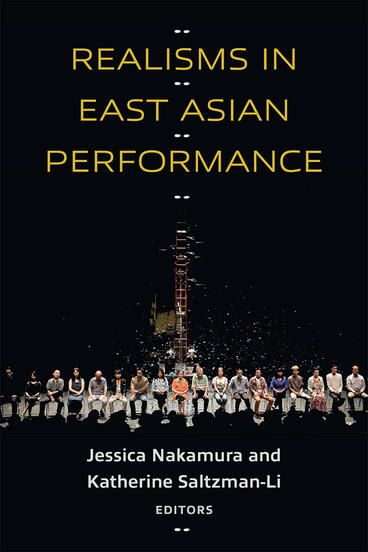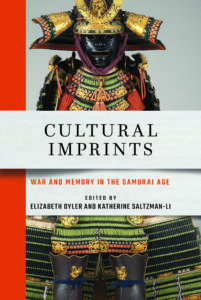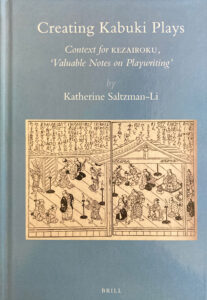Katherine Saltzman-Li
 Katherine Saltzman-Li
Katherine Saltzman-LiPh.D., Stanford University
Associate Professor
Department Chair
Specialization: Japanese performing arts, Japanese literature, folklore, comparative literature
Office: HSSB 2237
Office Hours: Please check each quarter.
Email:ksaltzli@eastasian.ucsb.edu
Katherine Saltzman-Li is Associate Professor of Japanese Studies, with affiliated appointments in the Program in Comparative Literature and the Department of Theater and Dance. She teaches courses on Japanese performing arts, Japanese literature, and folklore. She has published on kabuki plays, professional and commercial materials related to kabuki, and Japanese woodblock theatre prints, as well as translations of two early kabuki plays: the quintessential Edo-style piece “Shibaraku” and “Sanemori Monogatari,” a play adapted for kabuki from the puppet theatre.
She is the author of Creating Kabuki Plays: Context for Kezairoku, “Valuable Notes on Playwriting” (Brill, 2010). The book is organized around a study of the only extant treatise from the Edo Period (1603-1867) fully devoted to the work of playwrights. It examines kabuki play creation and playwrights, as well as interactions among various artistic groups (including actors, writers, poets, and fine artists) of the latter half of the Edo Period.
She is co-editor of Cultural Imprints: War and Memory in the Samurai Age (Cornell University Press, 2022), which examines how writers, artists, performers, and samurai themselves viewed warfare and its lingering impact at various points during the “samurai age,” referring to the seven centuries of samurai rule that ended in the late 19th century. The volume addresses the warrior’s far-reaching, enduring, and varied cultural influence across these centuries and into the modern period.
Most recently she co-edited Realisms in East Asian Performance (University of Michigan Press, 2023), a group of essays on theatrical realism in a range of East Asian performance forms. The volume challenges the domination of Euro-American definitions of realism, based as they are on a limited corpus of plays from the late 19th-century. It identifies and analyzes instances of theatrical realism from China, Korea, and Japan across premodern, modern, and contemporary periods. Through its case studies, it expands scholarship on concepts and practices of theatrical realism and proposes a reconsideration globally.
She has co-curated two exhibitions of theater prints at the Santa Barbara Museum of Art: “Presenting Noh Drama: Theater Prints of Tsukioka Kōgyo” (2011) and “The Loyal League: Images from Japan’s Enduring Tale of Samurai Honor and Revenge” (2018). In ongoing work, she is a director of Japanese Performing Arts Research Consortium (JPARC), an international group of scholars devoted to the development of online resources on Japanese performing arts.
Publications

Realisms in East Asian Performance, University of Michigan Press, 2023. (Co-edited volume)

Cultural Imprints: War and Memory in the Samurai Age, Cornell University Press, 2022 (Co-edited volume)

Creating Kabuki Plays: Context for Kezairoku, “Valuable Notes on Playwriting.” E.J. Brill, 2010.
Selected Articles
- “Communicating the Power of Identity: The Tsurane of ‘Shibaraku'” in A Kabuki Reader, History & Performance, ed. by S. Leiter. M.E. Sharpe, 2002.
- “‘Shibaraku’ (Just a Minute!)” Introduction and Translation. In Kabuki Plays on Stage, Vol.1: Brilliance & Bravado, 1697-1766, ed. by Brandon & Leiter. University of Hawaii Press, 2002.
- “‘Sanemori Monogatari’ (The Samemori Story)” Introduction and Translation. In Kabuki Plays on Stage, Vol.1: Brilliance & Bravado, 1697-1766, ed. by Brandon & Leiter. University of Hawaii Press, 2002.
- “Romantic Male Role Types: Kabuki’s Nimaime and the Innamorato of Commedia dell’Arte”. Text & Presentation, 2010.
- “Kabuki Knowledge: Professional Manuscripts and Commercial Texts on the Art of Kabuki” in Publishing the Stage, Print and Performance in Early Modern Japan, Shimazaki & Kimbrough, ed. Center for Asian Studies, University of Colorado Boulder, 2011.
- “Tsukioka Kōgyo’s Noh Prints: Revival and Performance.” Impressions, No. 37, 2016.
- “From Ataka to Kanjinchō: Adaptation of Text and Performance in a Nineteenth-Century Nō-Derived Kabuki Play.” Mime Journal, Vol. 27, 2021.
- “Performing Trauma and Lament: Gendered Scenes of Samurai Anguish on the Eighteenth-Century Kabuki Stage” in Cultural Imprints: War and Memory in the Samurai Age, Oyler & Saltzman-Li, ed. Cornell University Press, 2022.
- “Theatrical Realism on the Kabuki Stage: Methods and Theories” in Realisms in East Asian Performance, Nakamura & Saltzman-Li, ed. University of Michigan Press, 2023.
Courses Taught
- Japanese 80 Masterpieces of Japanese Literature
- Japanese 110A: Classical Japanese Literature
- Japanese 110B:Medieval Japanese Literature
- Japanese 111: Japanese Folklore
- Japanese 125: Intermediate Japanese Reading
- Japanese 149: Traditional Japanese Theater
- Japanese 156: The Cultural Roots of the Japanese Horror Film
- Japanese 169/269: Seminar in Traditional Japanese Theater
- Japanese 181: Classical Japanese
- Japanese 211: Bibliography and Research Methodology
- Japanese 235: Representation in Japanese and European Drama
- EACS 4A: East Asian Traditions: Pre-modern
- EACS 212: Canon Formation, Periodization, and Disciplinarity in East Asian Studies
- Comparative Literature 31: Major Works of Asian Literatures
- Comparative Literature 173: Life Stories
- Introduction to Comparative Literature (Freshman Seminar)
- Literary Practice and the Garden in Classical Japan (Freshman Seminar)
- Digital Humanities: Case Study in the Performing Arts (Honors’ Seminar)
- Intersections: Theater Artists and Scholars (Mellon Engaging Humanities Seminar)
